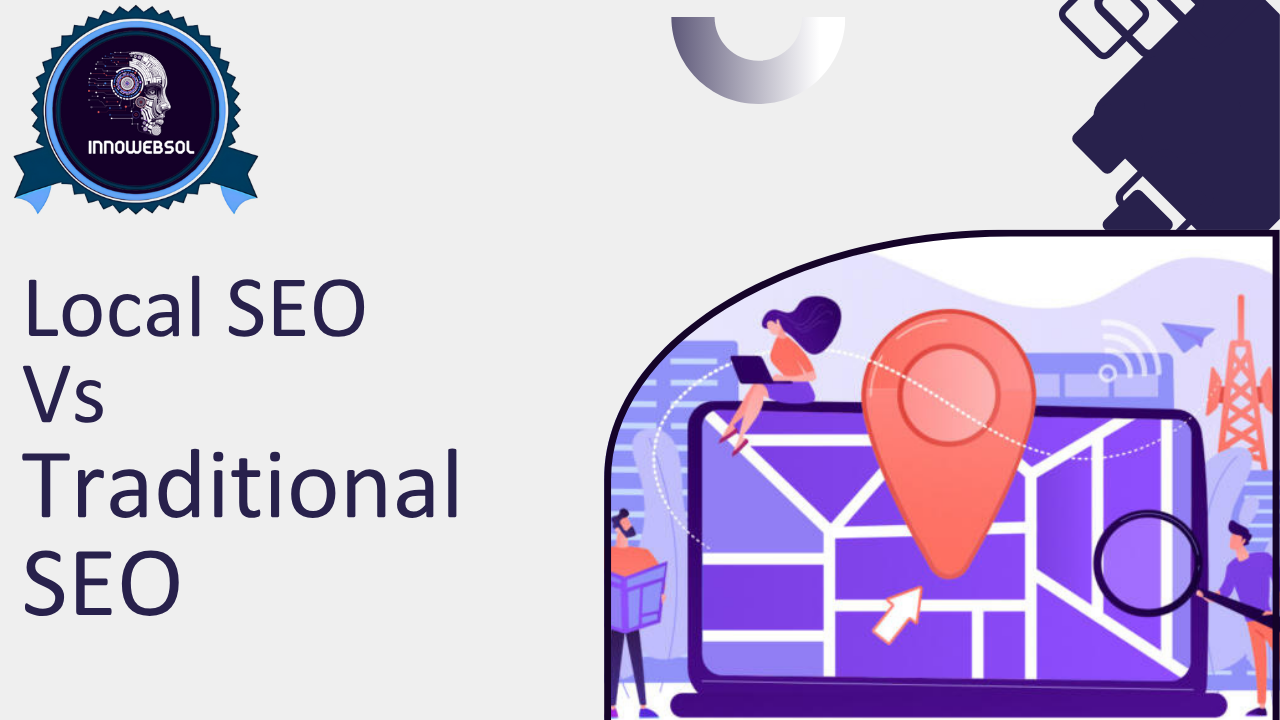In the world of digital marketing, businesses often wonder which strategy is best for growing online visibility: local seo vs traditional seo. Both approaches have unique strengths, but choosing the right one depends on your business goals, audience, and the markets you serve.
In this comprehensive guide, we’ll explore local seo vs traditional seo, explain how each works, and provide clear examples to help you decide which method—or combination of both—is right for your business.
What is Traditional SEO?
To understand local seo vs traditional seo, we first need to define Traditional SEO. Traditional SEO, sometimes referred to as organic SEO marketing, focuses on improving a website’s visibility in search engine results on a national or global scale. It’s designed to attract a broad audience regardless of specific geographic locations.
Key components of traditional SEO include:
Keyword research targeting generic or broad terms
Content optimization for informative or transactional searches
Technical SEO ensuring websites load fast and function smoothly
Backlink building to improve domain authority
Creating engaging content that attracts visitors and earns natural links
The primary goal of traditional SEO is to rank high in organic search results for keywords that drive relevant traffic from anywhere in the world.

What is Local SEO?
On the other side of the comparison between seo vs local seo, we have local SEO. Local SEO focuses on optimizing a business’s online presence for geographically specific searches. It aims to help businesses appear in search results when users search for services or products “near me” or include city or region names.
Local SEO strategies involve:
Optimizing Google Business Profile listings
Managing name, address, and phone number (NAP) consistency across directories
Getting reviews from local customers
Creating locally relevant content
Building citations from local websites or industry-specific directories
The ultimate goal of local SEO is to connect businesses with customers in their immediate area, driving in-person visits, phone calls, or local service requests.
Local SEO vs Traditional SEO: Key Differences
While both traditional and local SEO aim to increase visibility in search engines, there are crucial differences when comparing local seo vs traditional seo.
Geographic Targeting
Traditional SEO targets a wide audience without focusing on specific geographic locations. A business selling online nationwide would typically invest in traditional SEO.
Local SEO targets users within a specific geographic area. It’s ideal for businesses like restaurants, law firms, plumbers, or local retail stores.
Search Intent
Traditional SEO often targets informational or transactional searches, such as “best email marketing software” or “buy running shoes online.”
Local SEO focuses on searches with location-based intent, like “plumber in Dallas” or “best Italian restaurant near me.”
Search Results Display
Traditional SEO appears in standard organic search results.
Local SEO often appears in the “local pack” or map listings, showing business names, addresses, and ratings directly on the search results page.
Ranking Factors
Traditional SEO prioritizes factors like content quality, backlinks, and technical performance.
Local SEO places significant weight on factors like:
Proximity to the searcher
Google Business Profile optimization
Local reviews and ratings
Local citations consistency
Local SEO vs Traditional SEO Examples
To clarify local seo vs traditional seo, let’s look at some practical local seo vs traditional seo examples:
A nationwide e-commerce store selling fitness equipment would use traditional SEO strategies to rank for keywords like “buy treadmills online.”
A local gym would focus on local SEO to appear in searches like “gym near me” or “fitness center in Miami.”
A software company with clients worldwide would use traditional SEO to rank for terms like “project management software.”
A local accounting firm would target searches like “tax accountant in Chicago” through local SEO.
These examples show how the right SEO strategy depends on the audience you’re trying to reach.
How Traditional SEO and Local SEO Work Together
While it’s easy to think of seo vs local seo as two separate strategies, they often work best when combined. Many businesses benefit from a hybrid approach:
Local businesses that also sell online can use traditional SEO to attract non-local traffic while relying on local SEO for nearby customers.
Businesses expanding into new locations can use local SEO to build presence in each new market while maintaining traditional SEO for broader visibility.
Creating high-quality content helps both traditional and local rankings, as strong content builds authority, earns backlinks, and supports local relevance.
A combined strategy ensures you’re visible to both local customers searching nearby and broader audiences seeking your products or services online.
Benefits of Traditional SEO
Understanding the pros of traditional SEO helps clarify local seo vs traditional seo. Benefits include:
Broader audience reach beyond geographic boundaries
Higher potential search volume for non-location-specific keywords
Authority building through backlinks from global or national sources
Long-term ROI as organic rankings continue delivering traffic
Ideal for businesses that operate nationally, internationally, or primarily online
Benefits of Local SEO
Local SEO offers its own unique advantages:
Connects with nearby customers ready to buy
Appears in map results, increasing visibility and trust
Helps small businesses compete with larger brands locally
Improves chances of being chosen by customers who prefer local businesses
Drives in-person traffic for brick-and-mortar stores, restaurants, and service providers
Organic SEO Marketing and Local SEO: Shared Elements
Although there are differences between local seo vs traditional seo, they share common foundational practices:
Keyword research: Both require understanding user intent and choosing relevant keywords.
On-page optimization: Titles, headings, content, and meta descriptions must be optimized.
Technical SEO: A fast, secure, and mobile-friendly website helps all SEO efforts.
Content quality: Google prioritizes helpful, authoritative content for both types of SEO.
User experience: A well-designed, easy-to-navigate site supports both traditional and local rankings.
This shared foundation means businesses can implement universal SEO best practices while tailoring additional efforts to either traditional or local needs.
Challenges of Local SEO vs Traditional SEO
Both local and traditional SEO come with challenges:
Traditional SEO often involves competing against large, established brands with high domain authority.
Local SEO requires managing NAP consistency across many listings, earning genuine local reviews, and dealing with competitors targeting the same local audience.
Algorithm updates affect both. Google frequently changes ranking factors, impacting traditional search results and local map packs alike.
Staying updated and flexible is crucial for maintaining SEO success.
How to Choose Between Local SEO and Traditional SEO
When deciding between local seo vs traditional seo, consider these questions:
Does your business serve a specific geographic area or a wider market?
Do customers visit you in person, or do you operate entirely online?
Are your products or services relevant nationally, or do they cater to local demand?
Do you have the resources to manage both traditional and local SEO strategies?
For businesses operating only locally, local SEO should be the top priority. For online-only or nationally focused businesses, traditional SEO makes more sense. Many businesses will benefit from both.

Tips for Effective Local SEO
If local SEO is part of your strategy, follow these best practices:
Claim and fully optimize your Google Business Profile.
Ensure your business name, address, and phone number are consistent across all directories.
Encourage customers to leave positive reviews.
Create locally focused content, such as blog posts about local events or community news.
Build local backlinks from businesses, newspapers, and local blogs.
Monitor local rankings and adjust strategies as needed.
Tips for Effective Traditional SEO
If you’re focusing on traditional SEO, these practices are essential:
Target broad, high-volume keywords relevant to your industry.
Create long-form, high-quality content that answers user questions.
Earn backlinks from reputable sites in your niche.
Optimize technical aspects of your website for speed and usability.
Monitor keyword rankings and adapt to algorithm changes.
Final Thoughts on Local SEO vs Traditional SEO
Deciding between local seo vs traditional seo comes down to your business model and goals. Local SEO helps businesses connect with nearby customers, while traditional SEO offers broad visibility and opportunities for national or global reach. In many cases, combining both strategies leads to the best results.
Whether you’re a small business owner targeting local neighborhoods or a national brand seeking wider reach, understanding the differences and advantages of local seo vs traditional seo is essential. By applying the right strategies, you’ll increase your online presence, attract more customers, and achieve long-term success.

